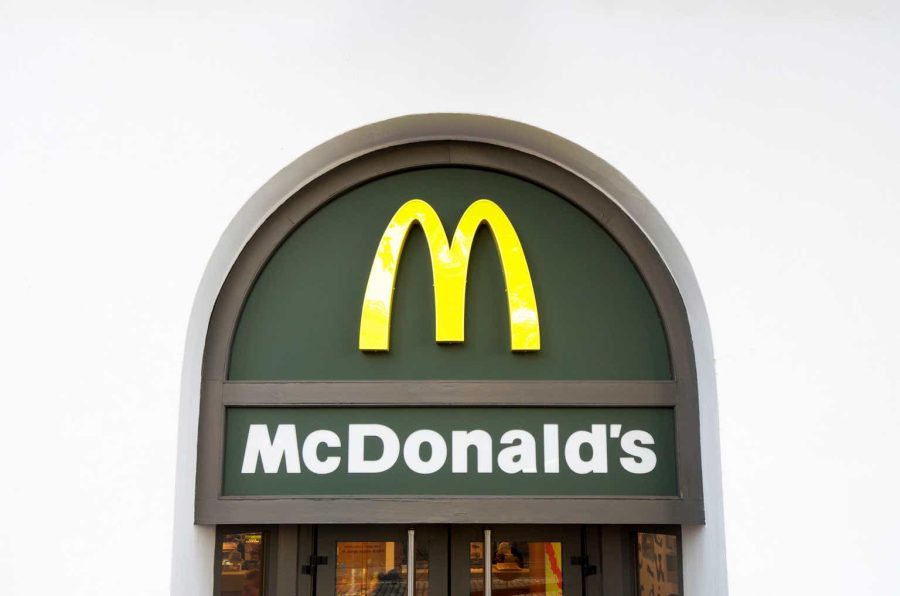April 27, 2024 Alphabet and Microsoft’s AI Investments Yield Strong Returns
April 26, 2024 Top 10 High Dividend Yield Stocks
Tesla Q1: Model 2 Could Be Their Model T
Tesla Is An AI Company That The Market Won’t Reward For Now
Amazon: The Margin Train Is Gaining Speed
April 23, 2024 Maximizing Profits: When is the Right Time to Sell Your Business?
April 12, 2024 Improve Your Financial Status: A How-To Guide
April 12, 2024 How ZIM Integrated Container Tracking is Revolutionizing Global Trade
March 15, 2024 6 Best Growth Stocks To Buy Now According to Metatrader 5

McDonald’s (MCD) Stock Forecast for 2024–2028. Sell or Buy?
Updated: April 27, 2024 (12:57)
Sector: Counsumer cyclicalThe share price of McDonald's Corp. (MCD) now
50/200 Day Moving Average: $282.41 / $281.34
This figure corresponds to the Average Price over the previous 50/200 days. For McDonald's stocks, the 50-day moving average is the resistance level today.
For McDonald's stocks, the 200-day moving average is the resistance level today.
Are you interested in McDonald's Corp. stocks and want to buy them, or are they already in your portfolio? If yes, then on this page you will find useful information about the dynamics of the McDonald's stock price in 2024, 2025, 2026, 2027, 2028. How much will one McDonald's share be worth in 2024 - 2028?
When should I take profit in McDonald's stock? When should I record a loss on McDonald's stock? What are analysts' forecasts for McDonald's stock? What is the future of McDonald's stock? We forecast McDonald's stock performance using neural networks based on historical data on McDonald's stocks. Also, when forecasting, technical analysis tools are used, world geopolitical and news factors are taken into account.
McDonald's stock prediction results are shown below and presented in the form of graphs, tables and text information, divided into time intervals. (Next month, 2024, 2025, 2026, 2027 and 2028) The final quotes of the instrument at the close of the previous trading day are a signal to adjust the forecasts for McDonald's shares. This happens once a day.
Historical and forecast chart of McDonald's stock
The chart below shows the historical price of McDonald's stock and a prediction chart for the next month. For convenience, prices are divided by color. Forecast prices include: Optimistic Forecast, Pessimistic Forecast, and Weighted Average Best Forecast. Detailed values for the McDonald's stock price can be found in the table below.
Long-term forecasts by years.

McDonald's Stock Forecast: Navigating Through Challenges and Opportunities

As investors closely monitor McDonald's (MCD) stock performance, several significant events and factors loom on the horizon, poised to influence its stock rate critically. Among these, the lack of top-line growth presents a formidable hurdle.
Deciphering the Impact of Market Dynamics on MCD Stocks
Recent tensions in key markets, notably Arab countries, coupled with an anticipated Q1 earnings report, are set to shape McDonald's stock trajectory in the near term. Analysts and investors are particularly keen on how these developments may affect investor confidence and, by extension, the MCD stock forecast.
Moreover, the high commodity prices impacting essential ingredients such as beef, pork, chicken, and coffee could significantly pressure the company's margins. This situation creates a two-pronged challenge for McDonald's: navigating increased operational costs without alienating customers through price hikes.
- Lack of top-line growth and recent challenges
- Impact of high commodity prices
- Anticipation surrounding the Q1 earnings report
For analysts aiming to make accurate MCD stock price predictions, focusing on these critical areas could provide a clearer picture of the stock's future trajectory. Will McDonald's manage to surpass expectations with its Q1 earnings report, or will the combined weight of growth challenges and high commodity prices prompt a revision of the MCD stock price target?
These considerations make MCD a stock to watch closely, with the upcoming period likely to offer a mix of challenges and opportunities for discerning investors. Deciding whether MCD is a good stock to buy or sell will depend on how well the company navigates these hurdles and capitalizes on potential avenues for growth.
Review the original Analysis

McDonald's Stock in the Crosshairs: Navigating Through Turbulent Waters

As investors and analysts keep a keen eye on McDonald's (MCD) stock forecast, several events and factors loom on the horizon, set to sway the MCD stock rates in significant ways. High on the list is the strain of high leverage and inflation, which are tightening the noose around cash flow, a cornerstone for investor confidence and stock stability. The burgeoning labor costs, compounded by the shift toward automation, emerge as another critical force, pressurizing the margins that McDonald's has traditionally enjoyed. These dynamics raise critical questions on whether MCD is a good stock to buy amid the evolving economic landscape.
Decoding the Market Signals for MCD Stocks
An intricate dance between maintaining affordability and ensuring profitability puts McDonald's in a tricky position, especially as limited pricing flexibility could reduce foot traffic, a lifeblood for the fast-food giant. While analyzing the MCD stock price prediction, analysts are closely monitoring the company's ability to tread through these challenges. Adjustments in response to rising labor and supply costs, alongside a solid commitment to green initiatives and proactive debt reduction, are pivotal elements that could either anchor or buoy MCD stock price target predictions.
For those pondering over MCD stock buy or sell, understanding these moving pieces offers a glimpse into McDonald's future. The ability to adapt amid these pressures while sustaining growth and profitability will be crucial. Hence, in making an MCD stock forecast or contemplating if McDonald's stock forecast tilts toward buy or sell, incorporating these factors could pave the way for more grounded and insightful predictions. The near future for MCD stocks will fundamentally hinge on McDonald's navigation through these economic tides and the strategic pivots the company undertakes to maintain its market stronghold.
Review the original Analysis

Forecasting Feast: Navigating McDonald's Stock Journey

In the vibrant world of stock market predictions, the appetite for McDonald's (MCD) stock forecast is substantial. Analysts keenly observe the factors that could stir up the MCD stock price prediction, seeking clues in the company’s robustness ratio, expansion strategies, capital allocation, and its powerful brand image. Each of these areas plays a critical role in crafting a well-informed MCD stock forecast, with the potential to either spice up or simmer down investor enthusiasm.
Key Ingredients for a Savvy MCD Stock Forecast
The near future for McDonald's stock rates dances around several pivotal events and traits. Top on the list is McDonald’s robustness ratio and its bargaining power over franchisees, a factor that grants it the capability to swell royalties without denting its profitability. This unique aspect not only supports a more stable cash flow but also colors the MCD stock buy or sell debate with a tint of optimism. Analysts dissecting the MCD name stock forecast lean on this factor heavily to spoon out predictions.
Further seasoning the McDonald's stock forecast pot are the company's business model tweaks and aggressive expansion plans, aiming to pepper the global market with more franchises. This move, alongside an unwavering commitment to shareholder returns through dividends and repurchases, adds a desirable flavor to the McDonald’s stock forecast. Not to be overlooked, the brand’s iconic image and competitive prowess furnish analysts with a rich base for predicting the MCD stock price target, making the question of whether MCD is a good stock to buy more intriguing.
- Robustness ratio and bargaining power over franchisees
- Expansion strategies and business model evolution
- Strategic capital allocation (dividends and repurchases)
- Brand image and competitive advantage
By chewing over these factors, analysts can whip up the most accurate and tantalizing forecasts for MCD stock, guiding investors on whether it's a time to buy, sell, or hold their shares in the golden arches. The quest for the next big, juicy bite in the stock market thus continues, with all eyes on McDonald's evolving story.
Review the original Analysis
McDonald’s Corporation is an American corporation, one of the largest fast food chains on the planet, which operates under a franchise system. McDonald’s serves more than 60 million customers a day, in more than a hundred countries around the world, the corporation has approximately 36,615 points. First of all, the fast food chain prepares hamburgers, cheeseburgers, fries, McChicken, Chicken McNuggets, milkshakes and more. Restaurants are operated either by franchises or by affiliates of McDonald’s itself. McDonald’s profits come from rents and fees paid by franchisees, as well as sales in their own restaurants.
The business began back in 1940, when brothers Richard and Maurice MacDonald opened the most ordinary restaurant. In 1948, the standards of the current “fast food” cafe began to be introduced into it, and the principles of food preparation became conveyor belts to speed up the process. In March 1953, McDnalds’ initial mascot was a man with a chef’s hat on his head, his name was “Speedee”, but in the end, by 1967, he was replaced by Ronald McDonald, the clown.
McDonald's daily forecast for a month
| Date | Target | Pes. | Opt. | Vol., % |
|---|---|---|---|---|
| Apr 29 | 276.45 | 272.58 | 281.91 | 3.42 |
| Apr 30 | 279.29 | 274.33 | 280.75 | 2.34 |
| May 01 | 281.66 | 279.62 | 283.28 | 1.31 |
| May 02 | 283.21 | 281.37 | 286.96 | 1.99 |
| May 03 | 288.95 | 285.41 | 292.99 | 2.66 |
| May 04 | 291.26 | 287.76 | 294.61 | 2.38 |
| May 05 | 289.87 | 285.38 | 294.66 | 3.25 |
| May 06 | 287.63 | 283.96 | 291.44 | 2.63 |
| May 07 | 284.53 | 282.12 | 290.08 | 2.82 |
| May 08 | 284.53 | 280.41 | 289.30 | 3.17 |
| May 09 | 280.76 | 276.06 | 284.06 | 2.90 |
| May 10 | 286.03 | 283.60 | 288.89 | 1.87 |
| May 11 | 284.53 | 279.83 | 289.36 | 3.41 |
| May 12 | 283.89 | 280.41 | 288.29 | 2.81 |
| May 13 | 283.53 | 278.29 | 285.02 | 2.42 |
| May 14 | 288.56 | 283.59 | 292.03 | 2.98 |
| May 15 | 295.71 | 291.64 | 299.18 | 2.59 |
| May 16 | 295.19 | 291.50 | 298.44 | 2.38 |
| May 17 | 298.36 | 295.68 | 303.51 | 2.65 |
| May 18 | 293.96 | 290.95 | 295.58 | 1.59 |
| May 19 | 297.05 | 291.55 | 301.36 | 3.36 |
| May 20 | 299.72 | 296.05 | 305.72 | 3.26 |
| May 21 | 304.07 | 302.24 | 309.62 | 2.44 |
| May 22 | 303.00 | 299.14 | 308.15 | 3.01 |
| May 23 | 308.08 | 306.08 | 311.47 | 1.76 |
| May 24 | 311.39 | 307.58 | 316.22 | 2.81 |
| May 25 | 312.48 | 310.22 | 318.42 | 2.64 |
| May 26 | 305.45 | 303.77 | 309.12 | 1.76 |
| May 27 | 302.40 | 297.93 | 305.87 | 2.66 |
| May 28 | 299.67 | 295.85 | 305.67 | 3.32 |
McDonald's Daily Price Targets
McDonald's Stock Forecast 04-29-2024.
Forecast target price for 04-29-2024: $276.45.
Positive dynamics for McDonald's shares will prevail with possible volatility of 3.310%.
Pessimistic target level: 272.58
Optimistic target level: 281.91
McDonald's Stock Forecast 04-30-2024.
Forecast target price for 04-30-2024: $279.29.
Positive dynamics for McDonald's shares will prevail with possible volatility of 2.288%.
Pessimistic target level: 274.33
Optimistic target level: 280.75
McDonald's Stock Forecast 05-01-2024.
Forecast target price for 05-01-2024: $281.66.
Positive dynamics for McDonald's shares will prevail with possible volatility of 1.293%.
Pessimistic target level: 279.62
Optimistic target level: 283.28
McDonald's Stock Forecast 05-02-2024.
Forecast target price for 05-02-2024: $283.21.
Positive dynamics for McDonald's shares will prevail with possible volatility of 1.949%.
Pessimistic target level: 281.37
Optimistic target level: 286.96
McDonald's Stock Forecast 05-03-2024.
Forecast target price for 05-03-2024: $288.95.
Positive dynamics for McDonald's shares will prevail with possible volatility of 2.589%.
Pessimistic target level: 285.41
Optimistic target level: 292.99
McDonald's Stock Forecast 05-04-2024.
Forecast target price for 05-04-2024: $291.26.
Positive dynamics for McDonald's shares will prevail with possible volatility of 2.323%.
Pessimistic target level: 287.76
Optimistic target level: 294.61
MCD (MCD) Monthly Stock Prediction for 2024
| Month | Target | Pes. | Opt. | Vol., % |
|---|---|---|---|---|
| May. | 266.53 | 257.95 | 276.05 | 6.56 |
| Jun. | 260.19 | 246.17 | 269.11 | 8.53 |
| Jul. | 256.55 | 252.60 | 266.96 | 5.38 |
| Aug. | 247.03 | 234.75 | 251.87 | 6.80 |
| Sep. | 234.92 | 225.22 | 243.64 | 7.56 |
| Oct. | 243.80 | 239.88 | 253.36 | 5.32 |
| Nov. | 241.93 | 231.60 | 247.35 | 6.37 |
| Dec. | 240.06 | 230.32 | 249.81 | 7.80 |
McDonald's forecast for this year
McDonald's Stock Prediction for May 2024
An downtrend is forecast for this month with an optimal target price of $266.533. Pessimistic: $257.95. Optimistic: $276.05
McDonald's Stock Prediction for Jun 2024
An downtrend is forecast for this month with an optimal target price of $260.189. Pessimistic: $246.17. Optimistic: $269.11
McDonald's Stock Prediction for Jul 2024
An downtrend is forecast for this month with an optimal target price of $256.547. Pessimistic: $252.60. Optimistic: $266.96
McDonald's Stock Prediction for Aug 2024
An downtrend is forecast for this month with an optimal target price of $247.029. Pessimistic: $234.75. Optimistic: $251.87
McDonald's Stock Prediction for Sep 2024
An downtrend is forecast for this month with an optimal target price of $234.924. Pessimistic: $225.22. Optimistic: $243.64
McDonald's Stock Prediction for Oct 2024
An uptrend is forecast for this month with an optimal target price of $243.804. Pessimistic: $239.88. Optimistic: $253.36
McDonald's Stock Prediction for Nov 2024
An downtrend is forecast for this month with an optimal target price of $241.927. Pessimistic: $231.60. Optimistic: $247.35
McDonald's Stock Prediction for Dec 2024
An downtrend is forecast for this month with an optimal target price of $240.064. Pessimistic: $230.32. Optimistic: $249.81
McDonald's (MCD) Monthly Stock Prediction for 2025
| Month | Target | Pes. | Opt. | Vol., % |
|---|---|---|---|---|
| Jan | 241.24 | 232.97 | 250.19 | 6.88 |
| Feb | 229.08 | 223.95 | 239.83 | 6.62 |
| Mar | 214.65 | 206.24 | 221.26 | 6.79 |
| Apr | 203.68 | 196.13 | 211.38 | 7.22 |
| May | 207.53 | 200.12 | 212.91 | 6.00 |
| Jun | 204.92 | 201.33 | 211.51 | 4.81 |
| Jul | 213.09 | 204.14 | 224.13 | 8.92 |
| Aug | 205.93 | 198.44 | 215.16 | 7.77 |
| Sep | 219.19 | 212.90 | 227.94 | 6.60 |
| Oct | 234.54 | 221.57 | 243.08 | 8.85 |
| Nov | 247.34 | 239.38 | 256.52 | 6.68 |
| Dec | 248.90 | 239.32 | 260.92 | 8.28 |
McDonald's (MCD) Monthly Stock Prediction for 2026
| Month | Target | Pes. | Opt. | Vol., % |
|---|---|---|---|---|
| Jan | 244.02 | 231.21 | 250.69 | 7.77 |
| Feb | 237.70 | 226.72 | 250.52 | 9.50 |
| Mar | 230.55 | 217.96 | 239.43 | 8.97 |
| Apr | 241.04 | 233.28 | 252.51 | 7.62 |
| May | 238.85 | 226.14 | 242.36 | 6.69 |
| Jun | 245.53 | 232.64 | 254.99 | 8.76 |
| Jul | 258.77 | 244.46 | 268.55 | 8.97 |
| Aug | 260.04 | 250.57 | 270.05 | 7.21 |
| Sep | 266.77 | 257.25 | 275.55 | 6.64 |
| Oct | 266.96 | 262.29 | 277.05 | 5.33 |
| Nov | 273.12 | 264.14 | 278.48 | 5.15 |
| Dec | 277.14 | 268.60 | 282.18 | 4.81 |
McDonald's (MCD) Monthly Stock Prediction for 2027
| Month | Target | Pes. | Opt. | Vol., % |
|---|---|---|---|---|
| Jan | 289.94 | 278.78 | 302.12 | 7.73 |
| Feb | 285.48 | 281.28 | 300.07 | 6.26 |
| Mar | 305.06 | 296.09 | 311.25 | 4.87 |
| Apr | 300.79 | 285.42 | 310.48 | 8.07 |
| May | 306.26 | 295.76 | 313.77 | 5.74 |
| Jun | 303.48 | 294.56 | 309.21 | 4.74 |
| Jul | 316.86 | 303.77 | 323.51 | 6.10 |
| Aug | 327.95 | 309.82 | 339.89 | 8.85 |
| Sep | 321.75 | 311.17 | 339.32 | 8.30 |
| Oct | 315.22 | 307.06 | 326.03 | 5.82 |
| Nov | 313.68 | 305.55 | 324.66 | 5.88 |
| Dec | 312.80 | 303.60 | 322.65 | 5.90 |
McDonald's (MCD) Monthly Stock Prediction for 2028
| Month | Target | Pes. | Opt. | Vol., % |
|---|---|---|---|---|
| Jan | 324.84 | 314.38 | 342.35 | 8.17 |
| Feb | 325.98 | 310.23 | 339.67 | 8.67 |
| Mar | 319.36 | 305.05 | 326.51 | 6.57 |
| Apr | 322.71 | 309.84 | 340.56 | 9.02 |
| May | 316.61 | 302.87 | 325.92 | 7.07 |
| Jun | 326.81 | 322.23 | 332.53 | 3.10 |
| Jul | 335.96 | 323.26 | 349.60 | 7.53 |
| Aug | 320.20 | 308.77 | 328.95 | 6.13 |
| Sep | 321.32 | 305.58 | 328.75 | 7.05 |
| Oct | 309.85 | 293.37 | 319.18 | 8.09 |
| Nov | 295.32 | 283.33 | 306.07 | 7.43 |
| Dec | 288.71 | 283.05 | 299.82 | 5.59 |
McDonald's information and performance
110 NORTH CARPENTER STREET, CHICAGO, IL, US
Market capitalization of the McDonald's Corp. is the total market value of all issued shares of a company. It is calculated by the formula multiplying the number of MCD shares in the company outstanding by the market price of one share.
EBITDA of McDonald's is earnings before interest, income tax and depreciation of assets.
P/E ratio (price to earnings) - shows the ratio between the price of a share and the company's profit
Price/earnings to growth
Dividend Per Share is a financial indicator equal to the ratio of the company's net profit available for distribution to the annual average of ordinary shares.
Dividend yield is a ratio that shows how much a company pays in dividends each year at the stock price.
EPS shows how much of the net profit is accounted for by the common share.
Trailing P/E depends on what has already been done. It uses the current share price and divides it by the total earnings per share for the last 12 months.
Forward P/E uses projections of future earnings instead of final numbers.
Enterprise Value (EV) /Revenue
The EV / EBITDA ratio shows the ratio of the cost (EV) to its profit before tax, interest and amortization (EBITDA).
Number of issued ordinary shares
Number of freely tradable shares
Shares Short Prior Month - the number of shares in short positions in the last month.
McDonald's (MCD) stock dividend
McDonald's last paid dividends on 02/29/2024. The next scheduled payment will be on 03/15/2024. The amount of dividends is $6.23 per share. If the date of the next dividend payment has not been updated, it means that the issuer has not yet announced the exact payment. As soon as information becomes available, we will immediately update the data. Bookmark our portal to stay updated.
Last Split Date: 01/01/1970
Splitting of shares is an increase in the number of securities of the issuing company circulating on the market due to a decrease in their value at constant capitalization.
For example, a 5: 1 ratio means that the value of one share will decrease 5 times, the total amount will increase 5 times. It is important to understand that this procedure does not change the capitalization of the company, as well as the total value of assets held in private hands.


































